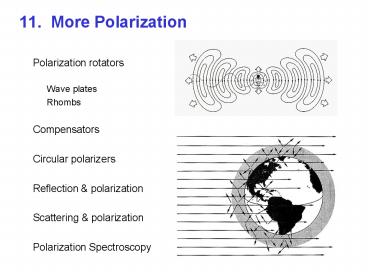11. More Polarization - PowerPoint PPT Presentation
1 / 20
Title:
11. More Polarization
Description:
When a beam propagates through a birefringent medium, one ... The Pile-of-Plates Polarizer ... is reflected on each surface, so you need a big pile of plates! ... – PowerPoint PPT presentation
Number of Views:79
Avg rating:3.0/5.0
Title: 11. More Polarization
1
11. More Polarization
- Polarization rotators
- Wave plates
- Rhombs
- Compensators
- Circular polarizers
- Reflection polarization
- Scattering polarization
- Polarization Spectroscopy
2
Wave plates
- When a beam propagates through a birefringent
medium, one - polarization experiences more phase delay than
the other. - If both polarizations are present, this has the
effect of changing - relative phase of the x and y fields, and hence
rotating the polarization. - Input
Polarization state
Output
3
Wave plates (continued)
- Wave plate output polarization state
(45-degree input polarization)
Quarter-wave plate
Half-wave plate
A quarter-wave plate creates circular
polarization, and a half-wave plate rotates
linear polarization to its orthogonal state. We
can add an additional 2mp without changing the
polarization, so the polarization cycles through
this evolution as d increases further.
4
Half-Wave Plate
When a beam propagates through a half-wave plate,
one polarizationexperiences half of a wavelength
more phase delay than the other.
- If the incident polarization is 45 to the
principal axes, then theoutput polarization is
rotated by 90. - If the incident polarization is parallel to one
of the principal axes of the plate, then no
polarization rotation occurs.
5
The Babinet Compensator rotates polarization by
an arbitrary amount.
Top wedge is cut with "fast" and "slow" axes cut
opposite to those of bottom wedge.
Input beam
Slide one wedge with respect to the
other, changing d1 and/or d2.
Note that this motion doesn't displace the beam!
Top wedge
Bottom wedge
6
The Fresnel rhomb uses total-internal-reflection
phase shifts to rotate polarization
- After two internal reflections, input 45
polarization rotates to - circular polarization.
Unlike polarization rotation in a wave plate,
this polarization rotation is nearly wavelength
independent.
7
Circular polarizers
- A circular polarizer makes circularly polarized
light by first linearly polarizing it and then
rotating it to circular. This uses a linear
polarizer followed by a quarter wave plate
Unpolarized input light
Additional QWP and linear polarizer comprise a
circular "analyzer."
Circularly polarized light
8
Depolarization by reflection or transmission
- Suppose that 45 polarization is incident on an
interface, which has different parallel (x) and
perpendicular (y) reflection coefficients.
Incident light fields
Reflected light fields
Unless light is purely parallel or
perpendicularly polarized or (incident at 0),
polarization rotation will occur in reflection
(or transmission).
9
Fresnel Reflection and Depolarization
- Fresnel reflections are a common cause of
polarization rotation.
This effect is particularly strong above
Bewster's angle.
10
Cruddy stuff depolarizes
- Cruddy stuff is very non-uniform a series of
interfaces at random angles.
Crossed polarizers with a piece of wax paper in
between.
11
Glare is horizontally polarized
Puddle reflection viewed through polarizer
that transmits only horizontally polarized light
Puddle reflection viewed through polarizer
that transmits only vertically polarized light
Light reflected into our eyes from the
puddle reflects at about Brewster's Angle. So
parallel (i.e., vertical) polarization sees zero
reflection.
Polarizer sunglasses transmit only vertically
polarized light.
12
The Pile-of-Plates Polarizer
- After numerous Brewster-angle transmissions,
mainly the parallel polarization remains.
Unfortunately, only about 10 of the
perpendicular polarization is reflected on each
surface, so you need a big pile of plates!
13
Scattering by molecules is not sphericallysymmetr
ic. It has a "dipole pattern."
- The field emitted by an oscillating dipole
excited by a vertically - polarized light wave
Direction of light excitation E-field and
electron oscillation
Emitted intensity pattern
No light is emitted along direction of oscillation
Directions of scat- tered light E-field
Directions of scat- tered light E-field
14
Dipole Emission Pattern from an Antenna
Analogous to a molecule emitting light, an
antenna emits a dipole pattern at much lower
frequency and longer wavelength
The pattern is somewhat distorted by the earth
and nearby objects.
15
Scattering of polarized light
- No light is scattered along the input field
direction, i.e. with k parallel to E.
Vertically polarized input light
Horizontally polarized input light
16
Scattering of unpolarized light
- Again, no light is scattered along the input
field direction, - i.e. with k parallel to Einput.
17
Scattering in the Earth's atmosphere leads to
interesting polarization properties of skylight.
Sun's rays
18
Skylight is polarized if the sun is to your side.
Right-angle scattering is polarized
This polarizer transmits horizontal
polarization (of which there is very little).
Polarizer transmitting vertical polarization
- Multiple scattering yields some light of the
other polarization. - In clouds, much multiple scattering occurs, and
light there is - unpolarized.
19
Brewster's Angle Revisited
When the reflected beam makes a right angle with
the transmitted beam, and the polarization is
parallel, then no scattering can occur, due to
the scattered dipole emission pattern. But
our right-angle assumption implies that qi qt
90. So Thus,
- A complex trigonometric calcu-
- lation reveals that the reflection
- coefficient for parallel-polarized
- light goes to zero for Brewster's
- angle incidence, tan(qi) nt / ni
20
Polarization Spectroscopy
The Pump pulse reorients molecules, which
induces some birefringence into the medium, which
then acts like a wave plate until the molecules
re-orient back to their initial random
distribution.

